Basic AI Chatbot Pricing: A simple chatbot that can answer questions about a product or service might cost around $10,000 to develop.
Read More
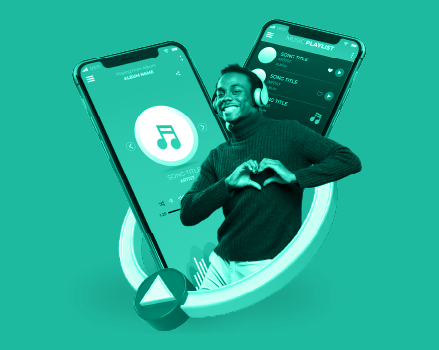
Music streaming app development has become a cornerstone for businesses aiming to offer end-to‑end, anytime-anywhere access to music. Whether you're looking to learn how to build a music streaming app, explore developing music streaming app features, or undertake full-scale music app development, now is the perfect time thanks to ubiquitous network connectivity and powerful mobile hardware.
Unlike video platforms, music apps can continue playing content in the background, offering a seamless experience even on low bandwidth. Today, advancements in generative AI are revolutionizing personalization by enabling highly tailored recommendations, automating playlist curation, and empowering emerging artists through unique content discovery.
The global music streaming market is booming. It reached an estimated USD 47.06 billion in 2025 and is expected to surge to USD 143.9 billion by 2032, growing at a 17.3 % CAGR. Meanwhile, Spotify, the category leader, now boasts 678 million monthly active users, including 268 million paying subscribers as of March 2025. In 2024, global music streams hit a record 4.8 trillion, propelled largely by female pop artists who also led genre growth.
These figures showcase massive potential: consumers are increasingly favoring digital music, and new technologies such as AI-driven discovery and immersive audio formats are opening fresh avenues for innovation. For developers and entrepreneurs, developing a music streaming app today means tapping into a vibrant market, capturing listener engagement, and crafting monetization models that match user expectations.
In this blog, we’ll walk you through the entire music streaming app development journey from ideation to launch, covering cost estimates, must-have features, monetization strategies, and key development steps to help your music app stand out in 2025 and beyond.
Online music streaming app development offers enormous potential in 2025, both for generating revenue and creating meaningful digital experiences. Understanding the core benefits to develop a music streaming app will help you align your investment with market demand and long-term growth.
One of the biggest financial benefits to develop a music streaming app is the potential for consistent, recurring income. Subscription-based models, ad-free premium tiers, and in-app purchases offer predictable cash flow. Unlike one-time product sales, music streaming encourages long-term user relationships, with monthly billing and high renewal rates. As your user base grows, so does your revenue, creating a scalable business model ideal for investors and entrepreneurs alike.
The global demand for digital music access continues to soar. With over 5 billion smartphone users and increasingly affordable internet, online music streaming app development allows your platform to serve audiences across geographies—be it North America, Southeast Asia, Africa, or Latin America. Music is universal, and by providing multilingual content and regional genres, you can tap into local cultures while building a global footprint.
Music streaming apps enjoy some of the highest user engagement rates among all app categories. On average, users spend hours per week listening to music, curating playlists, and discovering new artists. This stickiness makes your app a daily digital habit, which improves user retention and boosts advertising opportunities. For startups, it also means a stronger data loop for improving recommendations and features based on real behavior.
By investing in music streaming app development, you're not just creating a platform—you’re creating a brand. Your app can serve as a discovery hub for independent musicians, influencers, and content creators. Partnering with emerging artists not only enriches your catalog but also enhances your brand identity and user loyalty. It opens the door to exclusive content, live sessions, and even co-branded events, helping your platform stand out in a crowded market. For artists who need distribution to major platforms, online music distribution can streamline releases and metadata management.
With the integration of AI and machine learning now central to modern UX, music streaming platforms are leveraging these technologies to offer hyper-personalized experiences. Think smart playlists, mood-based suggestions, and context-aware content delivery (e.g., gym, work, travel). These AI-driven features significantly increase listening time, engagement, and overall user satisfaction. The more personalized your app feels, the more likely users are to return, subscribe, and recommend your platform—making AI a powerful engine for growth in online music streaming app development.
Unlike aggregator-based distribution (such as listing music on third-party platforms), developing your own music streaming app offers full control over content delivery, branding, monetization, and compliance. You decide how music is organized, promoted, and monetized—ensuring your brand’s voice is consistent throughout. You can also build custom tools for different user types (listeners, artists, admins), giving you an edge in both functionality and flexibility.
Together, these advantages make a compelling case for businesses and entrepreneurs exploring online music streaming app development. By tapping into a high-growth market with strong engagement potential, you can build a platform that delivers lasting value for users—and sustainable success for your brand.
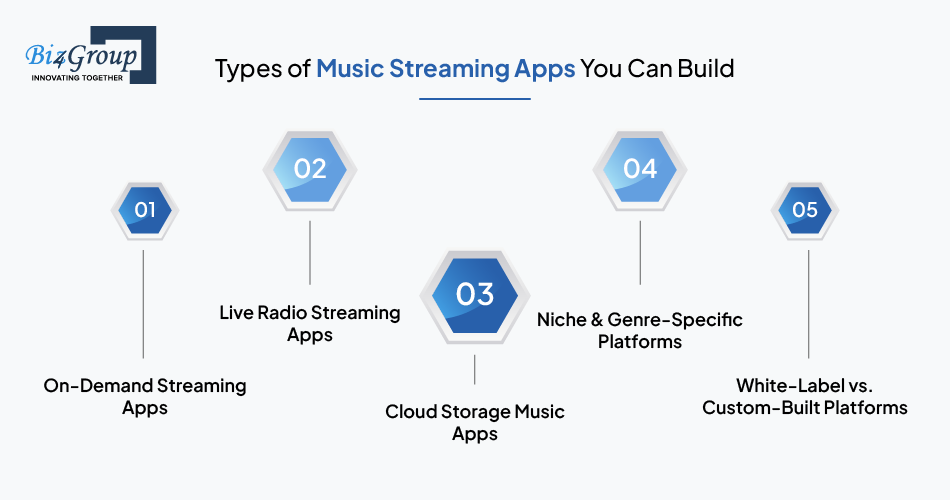
Before diving into music streaming app development, it’s essential to define what type of platform best fits your business goals, target audience, and technical resources. Understanding the various models can help you clarify your strategy and determine how to build a music streaming app that aligns with market demand.
Below are the main categories of music streaming apps you can consider in 2025:
These are the most popular types of music streaming platforms, allowing users to search, stream, and curate songs or playlists at any time. Leading services like Spotify and Apple Music have set high standards by offering features such as personalized recommendations, offline playback, lyrics integration, and podcast support.
From a development perspective, on-demand application development for music streaming requires robust content licensing, scalable cloud infrastructure, and advanced algorithms to support real-time playback, user preferences, and dynamic content delivery. Building such apps involves both a deep understanding of media streaming technologies and a focus on seamless user experience.
Live radio apps simulate the traditional radio experience in a digital format. Platforms like iHeartRadio and Pandora allow users to tune into curated radio stations, genre-based channels, and live DJ sessions without actively selecting individual tracks. These apps often include limited skip functionality and ad-supported listening in the free version. They're generally easier to build and license compared to full on-demand models, making them a cost-effective entry point for music streaming app development.
Cloud-based music apps allow users to upload their own music libraries and stream them across devices. Apps like YouTube Music and Audius offer hybrid experiences by combining user-uploaded content with licensed tracks or decentralized content sharing.
This type of app requires advanced cloud integration and storage management but can significantly reduce licensing costs, as much of the content is user-owned. Platforms like Audius are also pioneering blockchain technology to enable decentralized music streaming and artist-first monetization models.
These apps focus on specific music genres or highly targeted audiences—such as classical music enthusiasts, Lo-Fi beats fans, or listeners of regional and local language content. By catering to a well-defined niche, these platforms deliver curated libraries, specialized playlists, and community-driven experiences that mainstream apps often overlook. Niche streaming platforms are ideal for entrepreneurs exploring how to build a music streaming app that wins through focus and differentiation, rather than competing directly with large-scale players.
You can either build your app from scratch or use a white-label solution. Custom-built music streaming apps offer complete control over design, features, and backend architecture—but require higher investment and longer development time. White-label music platforms, on the other hand, allow you to launch faster and at a lower cost, with limited customization. This is often a great choice for startups or local radio stations entering the streaming space.
Choosing the right type of music streaming app is the foundation of your development strategy. Whether you're targeting a mass-market audience or a niche segment, understanding these models will help you prioritize features, manage licensing, and plan a successful launch.
Turn your idea into a full-featured music streaming platform with expert guidance.
Start Your Project TodayOne of the most important aspects of music streaming app development is planning how your app will generate revenue. With millions of users consuming audio content daily, understanding how music streaming apps make money is key to building a sustainable business model.
Here are the most effective and widely used monetization models for audio streaming apps in 2025:
This is the most common revenue model used by apps like Spotify and YouTube Music. Users get free access with ads and limited features, while premium users enjoy ad-free listening, offline playback, and high-quality audio.
Why it works:
In this model, users pay a monthly or yearly fee to access premium content or services. Pricing can vary based on tier (individual, family, student) and features offered.
Why it works:
Audio ads, banner ads, and sponsored content are played during the free-tier listening experience. These ads can be programmatic or sold directly to advertisers.
Why it works:
Users can purchase add-ons like premium tracks, custom playlists, sound enhancements, or even tip artists directly. Some platforms also sell concert tickets or exclusive merch.
Why it works:
Some apps earn revenue by licensing their technology, content catalog, or curated playlists to third-party services, media platforms, or device manufacturers.
Why it works:
Selecting the right audio streaming app revenue model depends on your target audience, content strategy, and long-term goals. A hybrid approach—combining freemium access, subscriptions, and advertising—often provides the best balance between user growth and profitability.
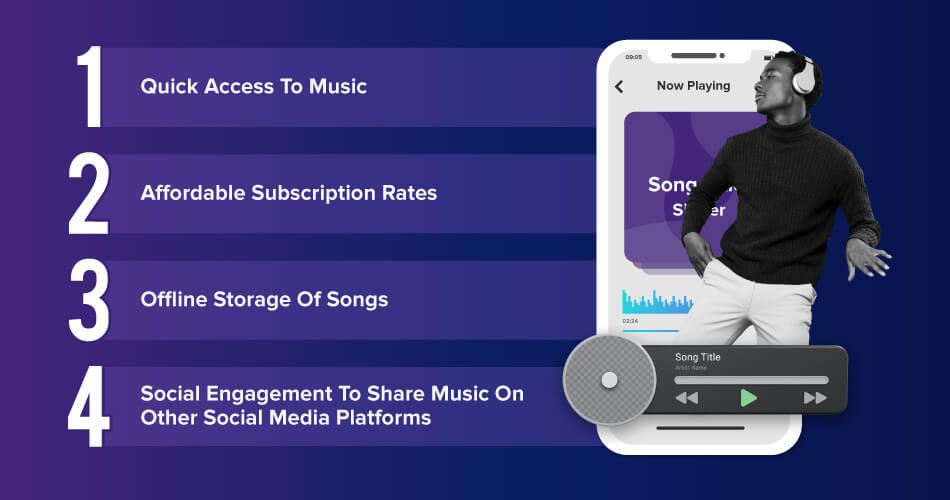
A good music streaming app must possess the following features:
Apart from these music app features, here is a breakdown of the features for the User and Admin Panel.
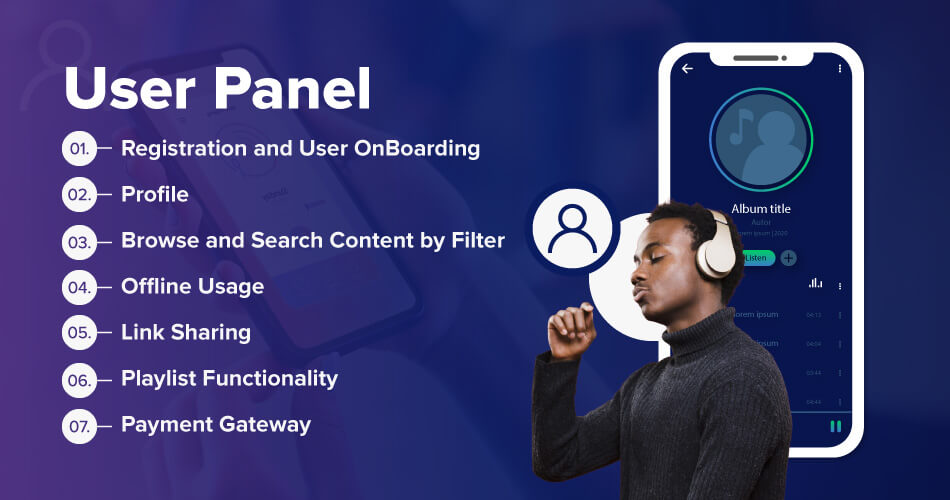
To ensure a seamless and engaging experience, the user panel of a music streaming app must offer intuitive, functional, and personalized features that cater to modern listening habits.
Book a consultation with our experts to refine your MVP and strategy.
Schedule a Free Consultation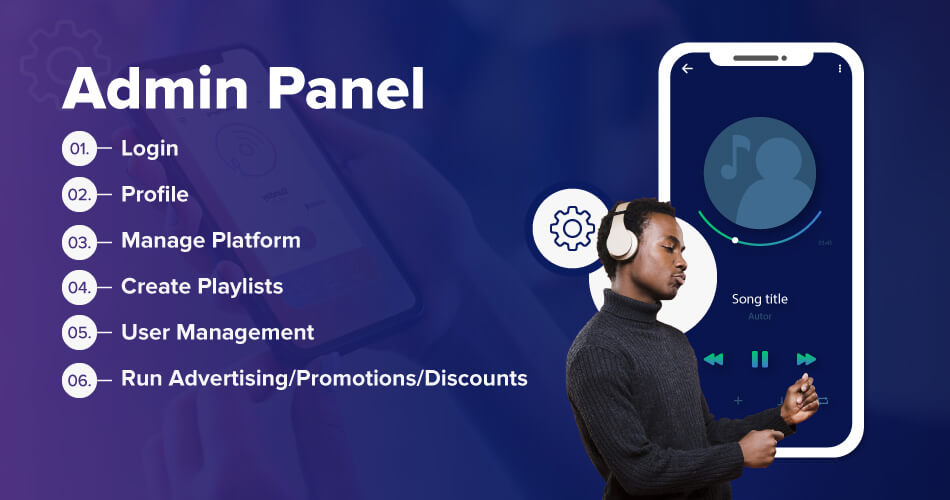
The admin panel is the control center of your music streaming app, enabling smooth operations, content management, and strategic decision-making.
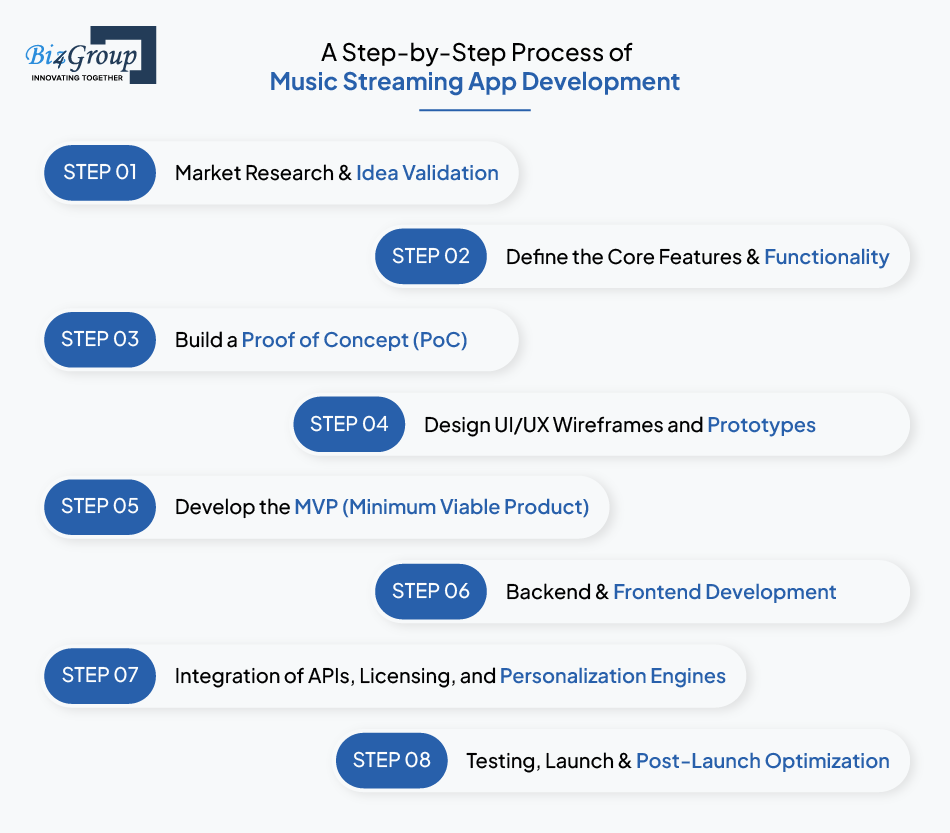
The successful development of a music streaming app involves more than just coding—it requires thoughtful planning, user-focused design, and scalable technology choices. Whether you're aiming to launch an MVP or a full-featured platform, understanding the entire workflow is key to effectively building a music streaming app that resonates with users and performs reliably in the real world.
Here’s a step-by-step guide to create a music streaming app from concept to launch:
Before you create a music streaming app, you need to understand your audience and competitors. Research popular platforms like Spotify, Apple Music, or niche players to identify what works and where the gaps lie. Validate your idea through user surveys, interviews, or early landing pages. This step ensures you solve a real problem and avoid building features nobody wants.
Goal: Define your audience, value proposition, and competitive edge.
Based on your research, create a detailed list of essential features for both the MVP and the full-scale version. Prioritize core streaming capabilities—like search, playback, and playlists—while mapping out advanced functions like AI-based recommendations, podcast integration, and social sharing.
Goal: Align product scope with user needs, business goals, and development budget.
A PoC is a technical prototype used to validate your concept’s feasibility. It helps answer critical questions like: Can the app stream music efficiently? Will it scale with thousands of users? Can it integrate with music APIs and deliver smooth playback? Building a PoC early reduces the risk of technical surprises later in development.
Goal: De-risk your project by validating core technology decisions upfront.
Also Read: Top PoC Software Development Companies in USA
This is where your app takes visual form. Collaborate with an experienced UI/UX design company to create wireframes that map out every screen, user interaction, and design element. Use tools like Figma or Adobe XD to build interactive prototypes that simulate real user journeys. Strong UI/UX can significantly increase user retention and satisfaction, especially in content-heavy apps like music platforms.
Goal: Create a visually appealing, intuitive, and device-responsive user interface.
Also Read: Top UI/UX Design Companies in USA
MVP development is the most critical phase in the early stage of music streaming app development. Focus on building just enough functionality to test the core value proposition with real users. Include essential features like sign-up/login, music playback, basic search, and playlist creation. By launching early and iterating fast, you can save costs and make data-driven improvements.
Goal: Validate your product in the market with minimal investment and faster time-to-market.
Also Read: Top MVP Development Companies in USA
At this stage, your development team builds the app's infrastructure. The backend handles music databases, user accounts, streaming logic, and licensing controls. The frontend covers all user-facing features across iOS, Android, and web platforms. Use a scalable tech stack (e.g., Node.js, MongoDB, React Native) to ensure the app performs well under load and can easily integrate third-party APIs or AI engines.
Goal: Create a secure, scalable, and efficient music streaming architecture.
Music apps require legally acquired content or licensed APIs from platforms like Spotify, Apple Music, or custom music labels. If building your own CMS, ensure copyright compliance and royalty tracking. Implement AI/ML engines for personalized music recommendations, dynamic playlists, and context-aware features (e.g., mood, time of day, user activity).
Goal: Enhance user satisfaction with personalized and legally compliant content.
Conduct comprehensive testing across devices, operating systems, and network conditions. Run functional, performance, and security tests. Once stable, launch the MVP to a closed beta or live market. Post-launch, use analytics tools to monitor engagement, feature usage, and drop-off points. Continue to refine and scale your app based on user feedback.
Goal: Deliver a high-quality, bug-free app and evolve it with real-world insights.
Following a structured development plan—from idea to MVP to full-scale product development—is essential when you create a music streaming app in today’s competitive market. With the right research, design, and development phases in place, your app can deliver a seamless listening experience while achieving long-term business success.
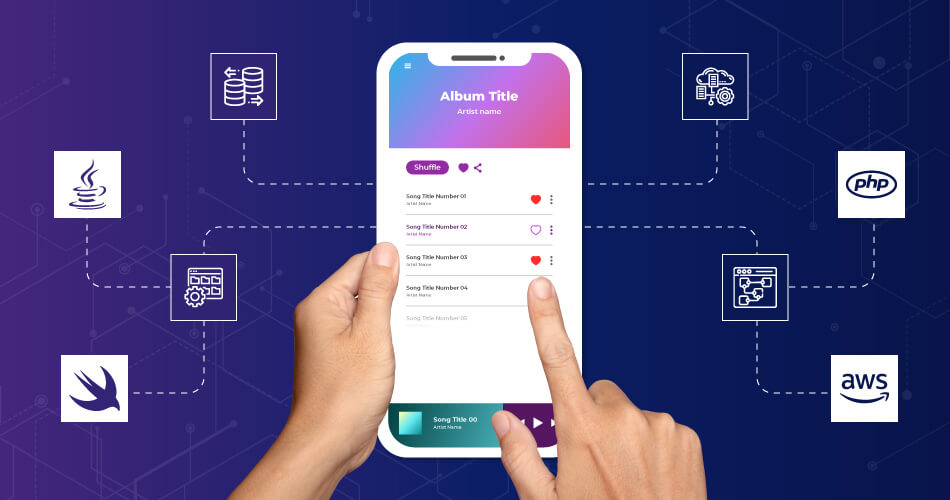
Choosing the right technology stack is essential to ensure high performance, scalability, and a smooth user experience in your audio streaming platform. Here's a complete tech stack breakdown for robust audio streaming app development.
| Component | Tools/Technologies | Purpose |
|---|---|---|
|
Frontend (Mobile/Web) |
React Native, Flutter, Swift (iOS), Kotlin (Android) |
To build a responsive and cross-platform user interface for seamless user interaction. |
|
Backend Framework |
Powers the core app logic, APIs, user handling, and integrates with databases and storage. |
|
|
Database |
MongoDB, PostgreSQL, MySQL |
Stores user data, playlists, music metadata, and history securely. |
|
Cloud & Storage |
AWS S3, Google Cloud Storage, Azure Blob Storage |
Hosts audio files and static assets with high availability and reliability. |
|
Streaming Protocol |
HLS (HTTP Live Streaming), RTMP, WebRTC |
Ensures smooth real-time audio streaming with adaptive quality. |
|
Content Delivery Network (CDN) |
Cloudflare, AWS CloudFront, Akamai |
Distributes audio content globally with low latency and faster load times. |
|
Music Licensing API / CMS |
Spotify SDK, Apple MusicKit, Custom CMS |
Integrates licensed music catalogs or manages your own uploaded content. |
|
Authentication |
Firebase Auth, OAuth 2.0, Auth0 |
Secures user accounts and enables social or email logins. |
|
AI/Recommendation Engine |
TensorFlow, Amazon Personalize, Scikit-learn |
Powers smart music suggestions and personalized playlists based on user behavior. |
|
AI Frameworks |
PyTorch, TensorFlow, Hugging Face Transformers |
Enables custom AI models for natural language processing, mood detection, and generative music suggestions. |
|
Analytics |
Google Analytics, Firebase Analytics, Mixpanel |
Tracks user behavior, feature engagement, and app performance metrics. |
|
Push Notifications |
Firebase Cloud Messaging, OneSignal |
Sends real-time alerts for updates, releases, and personalized content. |
|
Payments & Subscriptions |
Stripe, Razorpay, PayPal, RevenueCat |
Manages in-app purchases, subscription plans, and recurring payments. |
|
Admin Panel Framework |
React.js (Web), Angular |
Allows admin to manage users, content, analytics, and platform settings. |
|
DevOps & Hosting |
Docker, Kubernetes, AWS EC2, Heroku |
Handles app deployment, server orchestration, and scalability. |
|
Security Tools |
SSL, JWT, OAuth 2.0, OWASP best practices |
Ensures encrypted data transfer, user privacy, and secure authentication. |
A future-ready tech stack for online music streaming app development should blend performance, security, and personalization. By incorporating modern AI frameworks, you're better equipped to deliver intelligent, user-centric experiences that stand out in a competitive market.
Before you create a music streaming app, securing proper licensing is vital to ensure legal compliance and a rich music catalog. There are two primary types of licenses to consider:
Public Performance Rights: These are necessary for streaming music to the public. Acquiring these rights typically involves negotiations with music rights organizations (like BMI, ASCAP, or SESAC in the USA) that represent songwriters, composers, and music publishers.
Mechanical Licenses: These are required for reproducing and distributing musical compositions. They are usually obtained from music publishers or through agencies like the Harry Fox Agency in the USA.
In addition to these, synchronization licenses might be required if you plan to pair music with visual media. Also, consider direct agreements with record labels, especially for popular tracks, which can be more expensive but essential for a competitive music catalog.
Cost Implications: Licensing costs vary based on the music's popularity, the artist, and the type of license. Budget accordingly, as these costs can be significant.
Legal Considerations: Ensure compliance with international copyright laws, especially if your app serves a global audience. This may involve obtaining licenses from multiple countries.
Strategic Partnerships: Collaborating with established music licensing companies can simplify the process and provide access to a broader music library.
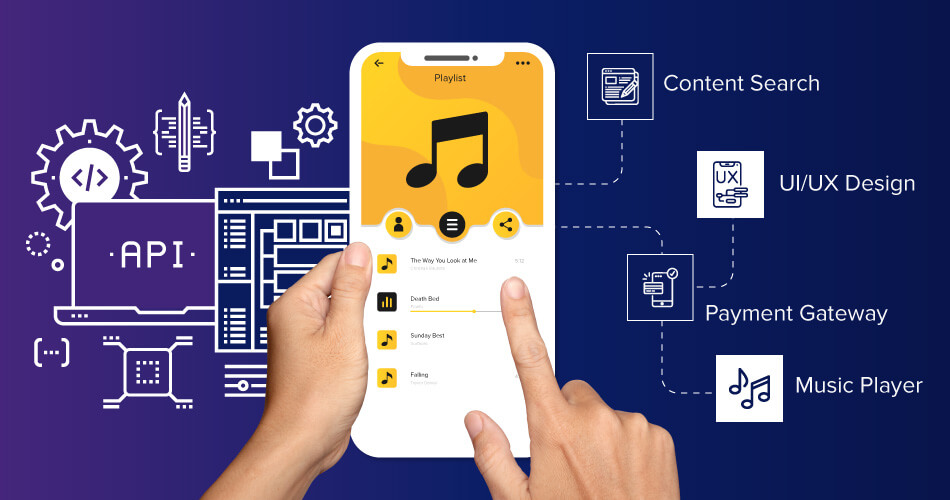
| Features | Timeline |
|---|---|
|
UI/UX design |
150-180 hours |
|
User Login and Profile |
40- 60 hours |
|
Content Search |
120-150 hours |
|
Payment Gateway |
80-90 hours |
|
Admin Panel |
200-250 hours |
|
Social Sharing |
60-70 hours |
|
Personalized Music Recommendation |
100-150 hours |
|
Music Player |
70-90 hours |
|
Player manager |
70-80 hours |
Considering the above features, the total cost to build a music streaming app in the USA would range from $20,000-$30,000. On the other hand, an app with advanced functionalities, third-party APIs, etc., can be priced between $50000-$60000.
Also Read: AI App Development Cost
Get a detailed estimate based on your features, timeline, and tech stack.
Request a Free QuoteWhile the market is booming, the path to launching a successful audio platform isn't without hurdles. Below are the most common challenges in developing a music streaming app—along with proven solutions to help you navigate them during each development phase.
Challenge: Obtaining legal rights to stream music is one of the most complex and expensive steps. Without proper licensing from publishers, labels, and rights holders, your app can face legal risks.
Solution:
Partner with licensing agencies (like ASCAP, BMI, or SoundExchange) or use platforms like Spotify SDK or Apple MusicKit to ensure content is pre-cleared. If you're building your own catalog, work directly with artists or aggregators and include royalty tracking in your CMS.
Challenge: Streaming high-quality audio to users worldwide requires robust server infrastructure, high storage capacity, and bandwidth—all of which can be expensive to scale.
Solution:
Use scalable cloud services (like AWS or Google Cloud) and integrate adaptive streaming protocols like HLS. Implement caching with CDNs to reduce server load and latency, which helps lower ongoing delivery costs.
Challenge: Users expect near-instant playback, even with large audio libraries and low internet speeds. High latency leads to poor UX and increased churn.
Solution:
Optimize buffer management, implement preloading techniques, and compress audio files using codecs like AAC or Opus. Test app performance under varied network conditions and use monitoring tools like New Relic or Datadog to proactively fix bottlenecks.
Challenge: Delivering personalized experiences is essential—but inaccurate or irrelevant suggestions can frustrate users and reduce engagement.
Solution:
Leverage AI and machine learning frameworks (like TensorFlow or Amazon Personalize) to create dynamic playlists and improve personalization. Collect behavioral data ethically and refine algorithms based on user feedback and engagement patterns.
Challenge: With giants like Spotify and Apple Music dominating the space, it’s hard for new apps to capture attention.
Solution:
Identify a niche—like genre-specific content, regional language music, or artist-first models. Focus on branding, exclusive content, and social features (like shared playlists or listening parties) to offer something unique.
Challenge: Apps handle sensitive user data, subscriptions, and usage behavior. Any data leak or weak security can result in trust loss and legal action.
Solution:
Follow OWASP security practices, encrypt all data transfers, and implement secure authentication (OAuth 2.0, JWT). Ensure GDPR, CCPA, and local privacy law compliance from day one.
Understanding and proactively addressing these music streaming app development challenges and their solutions ensures smoother execution and long-term success. With proper planning, the right tech stack, and strategic development, you can build a music app that stands out and scales with ease.
The music industry is undergoing rapid transformation, and so is the way people discover, listen to, and interact with music. From immersive experiences to decentralized platforms, the future of music streaming will be driven by innovation, AI, and user connectivity. Here are the top trends redefining the next wave of music streaming platforms:
AI will continue to play a major role in delivering hyper-personalized listening experiences. Future platforms will go beyond genre or artist-based suggestions to offer mood-aware playlists, location-specific tracks, and even generative music tailored to a user’s emotions or activity. As AI models evolve, apps will become smarter in anticipating user needs before they even search.
Spatial audio, including Dolby Atmos and 3D sound, is gaining popularity for offering a cinematic, immersive music experience—especially with headphones and smart speakers. Future streaming apps will integrate these technologies more deeply, offering concert-like realism and layered audio positioning, enhancing user engagement and emotional connection to music.
The rise of social audio is making music a shared, real-time experience. Features like live rooms, collaborative playlists, and simultaneous listening with friends will become mainstream. This social layer transforms music from a solitary activity into a communal one—boosting user retention and driving virality for new tracks.
As smart assistants and wearables become more intelligent and widespread, users will increasingly rely on voice commands to control their music. Streaming apps will need seamless integration with devices like Apple Watch, Google WearOS, Alexa, and smart earbuds to support hands-free, on-the-go listening.
Web3 technologies are disrupting how music is distributed and monetized. Platforms like Audius are pioneering decentralized models where artists have full control over their content, royalties are transparent, and fans can support creators directly through tokens or NFTs. Future apps may adopt hybrid models to offer both traditional and blockchain-based features.
To stay competitive in the coming years, music platforms must embrace these innovations and shift from being mere players to full-fledged ecosystems. Integrating these future-forward trends will not only elevate the user experience but also unlock new monetization paths and artist empowerment.
If you’re wondering how to create a music streaming app that stands out in a competitive market, choosing the right development partner is the first and most critical step. Biz4Group is a trusted mobile app development company known for building scalable, innovative, and AI-powered digital products.
With deep expertise in music streaming app development, we help businesses launch future-ready platforms that combine performance, personalization, and profitability.
Here’s what sets us apart:
At Biz4Group, we have hands-on experience in building custom streaming platforms tailored for modern users. Whether you're targeting mainstream audiences or niche listeners, we design apps that deliver seamless playback, intuitive navigation, and real-time content delivery.
We integrate intelligent AI solutions that enhance user experience through smart recommendations, auto-generated playlists, mood-based curation, and behavioral analytics. Our AI capabilities ensure your music app evolves with user preferences, increasing engagement and retention.
From idea validation and product strategy to UI/UX design, backend infrastructure, and post-launch maintenance—we offer complete, full-stack development services. Whether you need a cross-platform MVP or a fully custom native app, we handle every stage of music streaming app development with precision.
We build your app with future growth in mind. Using industry-best practices, our team ensures your platform can handle high user volumes, integrate third-party APIs, manage complex music libraries, and meet strict licensing and security requirements.
As a top-rated app development company in USA, we prioritize collaboration, timely updates, and clear communication. You’ll have a dedicated project manager and direct access to developers throughout the journey.
So, Partner with Biz4Group and bring your vision music streaming app development services to life with advanced tech, strategic insight, and a results-driven process. Whether you're still exploring how to create a music streaming app or ready to scale, we’re here to help you make it happen—brilliantly.
Future-Proof Your Music Streaming App
Talk to an Innovation ExpertThe music streaming industry is evolving faster than ever, driven by innovation, AI, and user demand for personalization and accessibility. Whether you're targeting a global audience or a niche community, the development of a music streaming app in 2025 offers immense opportunities for growth and long-term success. From selecting the right tech stack to navigating licensing and building MVPs, a strategic approach ensures your platform is scalable, engaging, and future-ready.
By staying ahead of market trends—like spatial audio, social listening, and blockchain integration—you position your app for continued relevance and user loyalty. Now is the ideal time to turn your music app idea into reality.
Ready to bring your vision to life? Book an appointment with our experts and start building your music streaming platform today.
Music streaming apps are categorized into Radio Streaming Services, Music Media Libraries, and Cloud Storage Based Music Players, each offering unique features.
Monetization strategies include a subscription model and advertisements, allowing revenue generation through premium services or ad placements.
Key music app features include quick access to music, affordable subscription rates, offline storage, and social sharing capabilities.
The technology stack to build a music streaming app typically includes Java or Kotlin for Android, Swift for iOS, JavaScript for front-end, PHP or Java for back-end, and various databases and cloud storage options.
The cost ranges from $20,000-$30,000 for an MVP in the USA, while more advanced apps with third-party APIs can cost between $50,000-$60,000.
Here is the process for on-demand music streaming app development:
with Biz4Group today!
Our website require some cookies to function properly. Read our privacy policy to know more.